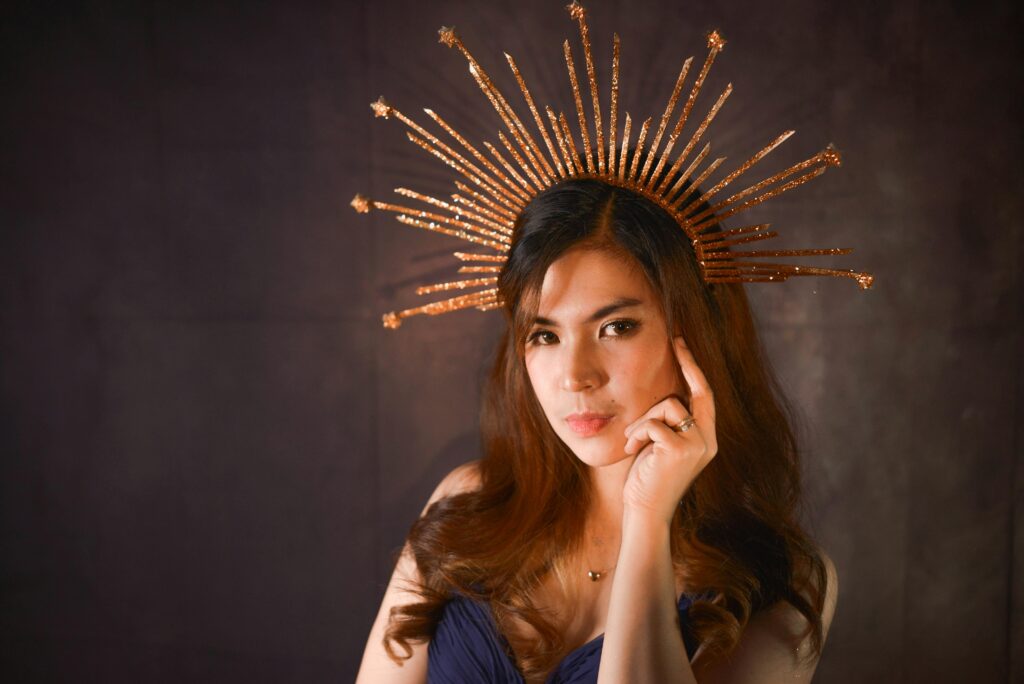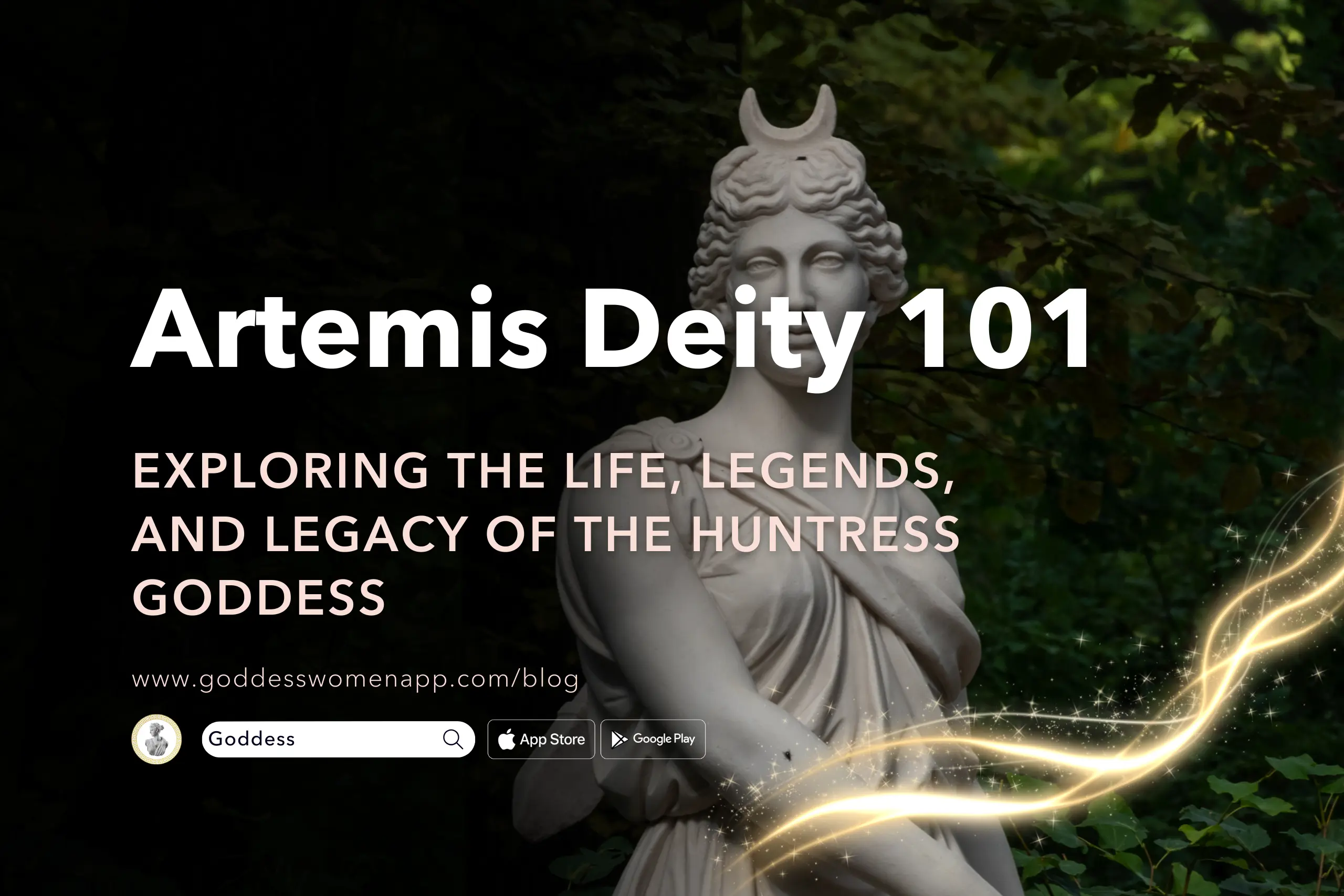Table of Contents
1. Introduction
Artemis deity, a revered Goddess in Greek mythology, stands out as one of the most fascinating ancient Greek deities. As the goddess of hunting and wild animals, Artemis embodies the spirit of the wild and the protector of young girls, drawing her power from her own hunting dogs and sacred animals. In ancient Greece, she was widely worshipped, particularly among the rural populace, and was known for her famous temple, named Artemis Orthia. Often depicted holding her golden bow and accompanied by hunting dogs, Artemis represents the virgin goddess of the hunt and the wilderness.

This Greek goddess has a rich mythology, being the twin sister of Apollo and the daughter of Zeus and Leto, who gave birth to them in a sacred grove. Artemis is portrayed as a virgin huntress and a symbol of the moon, often depicted with a crescent moon on her forehead. Her oath of eternal virginity made her a protector of young women and a guardian of childbirth. She is known to have fiercely protected her purity, with tales of Artemis killing those who violated it.
Artemis’s role in Greek mythology extends beyond her own myths, with her involvement in the stories of other deities, particularly her twin brother Apollo. Their relationship is detailed in various myths, including those that explore their status as patron god and goddess of hunting and archery. Artemis is also connected to tales involving sacred springs, chariots drawn by deer, and sudden death attributed to her golden arrows.
The goddess Artemis was associated with the moon and was part of the triple goddess aspect in ancient Greek religion, alongside Selene and Hecate. Her pre-Greek origin myths suggest that she was influenced by older fertility goddesses. In Greek legend, she was closely tied to wild nature and the full moon, often depicted with her brother Apollo as great hunters. Her connection to wild animals, particularly sacred animals like the deer, bull, and bear, was evident in the many temples dedicated to her, including the great lady Artemis of Ephesus.
The influence of Artemis on the ancient world extended to the cult of Artemis Orthia in Sparta, where young girls would dedicate themselves to the goddess through rigorous training and rituals. She was also invoked as a goddess of sudden death and protector of women in childbirth. As a deity, Artemis is not just a hunting companion or a goddess of hunting; she embodies the untamed spirit of nature itself, representing the moon goddess who walks through sacred groves, accompanied by her hunting companion and dogs and followed by the echoes of the Homeric hymn that praises her.

2. Who is Artemis Deity? Understanding the Greek Goddess
Artemis, a prominent deity in Greek mythology, holds a special place among the ancient Greek deities as the goddess of the hunt, the wilderness, and wild animals. Known as the virgin goddess, she was widely worshipped across the ancient world. The Greek goddess Artemis is often depicted holding her golden bow, with a crescent moon on her forehead, embodying the duality of the moon goddess and the virgin huntress. Her mythology is deeply intertwined with the sacred animals she protected and the wild nature she commanded.
Born in a sacred grove, Artemis is the twin sister of Apollo, who was born shortly after her. Their mother, Leto, gave birth to them in this secluded place, far from the wrath of Hera. Artemis had a pre-Greek origin, with myths suggesting she was originally a bull goddess or related to fertility goddesses. Her depiction in ancient Greek religion, however, cemented her role as a goddess of hunting and a protector of young girls and women.
In Greek legend, Artemis was a fierce protector of her eternal virginity. As a patron goddess of the wild, she transformed into a symbol of purity and strength. Many Greek gods revered her, and she was respected as a guardian of women, especially those giving birth. Her role in the lives of mortals and gods alike earned her a prominent place in the pantheon of Greek gods. Her temples dedicated to her, such as the famous temple named Artemis Orthia, became centers of worship, particularly for the rural populace who saw in her the protector of wild animals and young girls.
Artemis’s mythology is filled with tales of her fierce nature and dedication to her principles. The Greek goddess is said to have killed Actaeon when he saw her bathing, turning him into a stag before his own hunting dogs tore him apart. Another myth tells of her sending a giant scorpion to kill Orion after he attempted to assault her. In each story, the goddess demonstrates her prowess as a hunter and protector, accompanied by her hunting dog and companion, her brother Apollo.
The goddess of hunting was not only associated with wild animals but also sacred springs and the sacred groves where she was often worshipped. She was known to roam the forests with her hunting dogs, her chariot drawn by deer. As a moon goddess, she was part of the triple goddess aspect, which included Selene and Hecate. Her sacred animals, such as the deer and bear, were revered, and many rituals and offerings of sacred spring were made to honor her.
Artemis was depicted holding her golden bow and arrows, leading her followers on hunts through the wild nature she commanded. Her famous temple, known as the Temple of Artemis, was one of the Seven Wonders of the Ancient World. The maiden goddess remains a powerful symbol of independence, embodying the spirit of the huntress who lived beyond the constraints of society.
In conclusion, Artemis is a significant figure in Greek mythology, revered as a virgin goddess of the hunt and a protector of women. She continues to captivate us today with her timeless symbolism of wildness and independence, echoing the untamed spirit of the ancient world.

3. The Origins and Myths of the Greek Goddess Artemis
Artemis, an influential deity in ancient Greek mythology, stands out among the ancient Greek deities for her role as the goddess of hunting, wild animals, and the moon. In the ancient world, Artemis was revered as a virgin goddess with a fierce dedication to eternal virginity, embodying purity and independence. Her myths and origins are deeply rooted in the cultural landscape of ancient Greece, shaping her image as a huntress and protector of young girls and women.
Artemis was born to the Greek gods Zeus and Leto, and as the twin sister of Apollo, she shares a special bond with her brother, often joining him in various myths. The story goes that Leto gave birth to Artemis and Apollo on the island of Delos after wandering the earth to find a safe place to give birth. Artemis emerged first and assisted her mother with giving birth to her twin brother, Apollo. This tale highlights Artemis’s early association with childbirth and young women, reinforcing her role as a patron goddess of women in labor.
The myths of the Greek goddess Artemis include tales that showcase her duality as both a protector and a fierce enforcer of her principles. One such tale involves Niobe, the queen of Thebes, who boasted about her twelve children, comparing herself to Leto, who had only two. Artemis and Apollo, enraged by this insult, killed Niobe’s seven daughters and five of her sons, leaving her to mourn as a stone statue, eternally weeping. This myth demonstrates Artemis’s protective nature towards her family and the swiftness with which she punishes those who offend her.
In another tale, the hunter god Orion attempted to assault the goddess. In response, Artemis killed him by sending a giant scorpion to sting him, thereby immortalizing both the scorpion and Orion as constellations in the night sky. This story highlights Artemis’s ferocity in defending her honor and maintaining her status as a virgin goddess.

As a goddess of hunting, Artemis is closely associated with the wild nature of ancient Greece, often seen with her sacred animals like deer and bears. She is frequently depicted with her golden bow, accompanied by her hunting dogs, symbolizing her dominion over the wilderness. She is also linked to sacred springs and sacred groves, where she was worshipped in temples dedicated to her, such as the famous temple of Artemis in Ephesus, one of the Seven Wonders of the Ancient World.
Artemis was also part of the triple goddess aspect, alongside Selene, the personification of the full moon, and Hecate, the goddess of magic. This triad emphasized her connection to the moon and the cycles of life and death, as she was known to bring sudden death to those who offended her.
The myths surrounding Artemis, the maiden goddess, emphasize her role as a protector of young girls and the rural populace. They also reflect her association with sacred springs and the chariot drawn by deer, representing her connection to wild nature. In the Louvre Museum, a famous statue of Artemis portrays her with her hunting dogs, reinforcing her image as a greater hunter and protector of the wild.
In conclusion, the Greek goddess Artemis holds a prominent place in Greek mythology, with her myths and origins revealing her fierce independence, protective nature, and deep connection to the wilderness. From being a huntress and protector to a symbol of the moon and women, her legacy endures in the annals of myth and legend.

4. Artemis Among the Greek Gods: Her Relationships and Interactions
In the pantheon of ancient Greek deities, Artemis holds a unique place as a fierce protector and wild huntress. Her relationships with other Greek gods and goddesses, as well as her interactions with mortals, reveal her multifaceted personality and role in Greek mythology. As a virgin goddess of the hunt and moon, Artemis had numerous relationships that highlighted her influence and authority in the ancient world.
Artemis is the twin sister of Apollo, the Greek god of light, music, and prophecy. Their bond is deeply rooted in their shared mythology. They often collaborated, as seen in the tale of Niobe, where Artemis killed Niobe’s seven daughters while Apollo killed her five sons to avenge their mother’s honor. The two siblings, often depicted together, symbolize the duality of day and night, with Artemis embodying the moon goddess and Apollo representing the sun.
As a goddess of hunting, Artemis is often depicted with her own hunting dogs, leading her in the wild. She had a special bond with wild animals, particularly deer and bears, which were considered sacred animals. In one Greek legend, she is said to have transformed the nymph Callisto into a bear after she broke her vow of chastity, further reinforcing Artemis’s strict adherence to eternal virginity.
Artemis’s role as a patron goddess extended to protecting young girls and women, particularly during childbirth. In ancient Greek religion, she was worshipped in many temples dedicated to her, such as the famous temple in Ephesus. This widely worshipped goddess was especially revered by the rural populace, who saw her as a protector of wild nature and a guide in their everyday lives.
Her interactions with other Greek gods and goddesses often highlighted her protective nature and strong will. She was involved in several conflicts with other deities, especially those who challenged her purity or authority. One such instance involved Actaeon, a mortal hunter who accidentally stumbled upon Artemis while she was bathing. Outraged, the goddess Artemis transformed him into a stag, and he was subsequently torn apart by his own hunting dogs.
In addition to her own myths, Artemis was frequently invoked in the Homeric Hymns and other ancient texts, where her role as a virgin huntress and protector of the natural world was emphasized. Her chariot, drawn by deer, symbolizes her connection to the wild and the moon, as she guided her followers through the wilderness.
Despite her fierce reputation, myth, Artemis also had moments of compassion. She aided her mother, Leto, during childbirth, and was known to grant favors to those who honored her. In one myth, she saved Iphigenia from being sacrificed by transforming her into a deer, showcasing her power of transformation and mercy.
In ancient Greece, Artemis was a complex figure who represented both the fierce and nurturing aspects of femininity. As one of the most revered Greek goddesses, she maintained her place among the pantheon of Greek gods, not just as a goddess of hunting and the moon, but also as a protector of the vulnerable and a symbol of purity. Her legacy endures in Greek mythology, with her stories and relationships continuing to captivate the imaginations of those who encounter them.

5. The Legacy of Goddess Artemis in Greek Mythology
The legacy of the goddess Artemis in Greek mythology endures through the ages, rooted deeply in the cultural and religious fabric of ancient Greece. As a virgin goddess of the hunt and the moon, Artemis remains a symbol of wild nature and untamed spirit. Her influence on Greek mythology is evident in the myriad of stories, rituals, and symbols associated with her as a goddess of hunting, protector of wild animals, and a patron goddess for women and young girls.
Artemis’s legacy is intrinsically tied to her identity as a huntress. Her golden bow and crescent moon serve as enduring symbols of her dominion over the wilderness and her role as a protector of sacred animals and wild nature. Temples dedicated to the goddess Artemis, such as the famous temple in Ephesus, illustrate her wide-ranging influence as a deity in the ancient world. These temples became hubs of worship, where devotees offered sacrifices and prayers to honor the goddess and seek her favor.
Her role in Greek mythology extends beyond her hunting prowess. She played a crucial role in the lives of many gods, goddesses, and mortals alike. As the twin sister of Apollo, she shared a bond with her brother, standing by his side in various tales that highlighted their duality. As a protector of eternal virginity and young girls, Artemis transformed her own identity into a symbol of purity and strength. Her stories often emphasize her fierce protection of her principles, as seen when she killed Actaeon and transformed him into a stag, or when she sent a giant scorpion to slay Orion for his advances.
Artemis was also deeply associated with the moon and was often depicted in the form of a maiden goddess, embodying the cyclical nature of life. Her influence extended beyond the physical world to the spiritual, with many viewing her as a guardian of women in childbirth and a bringer of sudden death to those who offended her. As the goddess of hunting, she was a protector of the rural populace and deeply connected to the wild animals she revered.
Her pre-Greek origin myths suggest that she was initially associated with fertility goddesses and sacred springs, which evolved into her later associations with the hunt and moon. As a triple goddess, she was linked with Selene and Hecate, representing the different phases of the moon and the journey of women through life.
Despite being part of the pantheon of ancient Greek deities, Artemis stood out for her unwavering commitment to her values and her connection to wild animals and nature. The myths and legends that feature Artemis transformed her into an enduring figure whose stories continue to inspire. In modern interpretations, she represents the spirit of independence and empowerment, and her legacy lives on through art, literature, and popular culture.
In summary, the legacy of the Greek goddess Artemis is one of fierce independence, protection, and wildness. She remains a captivating figure in Greek mythology, her golden bow and crescent moon symbols of her enduring influence in the ancient world. Her legacy as a maiden goddess, protector of women, and huntress remains deeply ingrained in our cultural imagination.

FAQ
What is Artemis’s symbol?
Artemis is often associated with the bow and arrow, symbolizing her status as the goddess of hunting. Other notable symbols include the crescent moon, representing her connection greater hunter, to the moon and the wilderness, as well as wild animals like deer, which signify her role as their protector.
What are Artemis’s powers?
Artemis wields significant powers in Greek mythology. She is known for her exceptional hunting skills, mastery of archery, and protection over wild animals. As a moon goddess, she controls the moon’s influence, offering guidance and illumination. Artemis also has the power to bring sudden death with her arrows, often punishing those who violate her principles or threaten her sacred spaces.
What is the sacred animal of Artemis?
Deer are often considered the most sacred animal of Artemis. They are frequently depicted alongside her in ancient Greek art. However, other animals like bears and wild boars also hold sacred significance, reflecting her deep connection to the wild and untamed aspects of nature.
Is Artemis a boy or girl god?
Artemis is a female deity, revered in Greek mythology as the virgin goddess of hunting, the wilderness, and the moon. She embodies the qualities of independence, strength, and purity, and is often depicted as a maiden goddess who protects young girls and women.

6. Conclusion
Artemis, a revered deity in Greek mythology, stands as one of the most influential Greek goddesses. Her symbolism as the virgin huntress and moon goddess is steeped in the wild nature of ancient Greece, where she ruled over sacred animals and guided young girls through her role as a protector. With her golden bow in hand and crescent moon atop her brow, Artemis transformed into a patron goddess for those who dared to seek adventure and the mysteries of the wild.
As the twin sister of Apollo, Artemis was closely bonded with her brother, sharing in many adventures and conflicts throughout Greek mythology. The goddess Artemis defended her principles fiercely, punishing those who threatened her virtue or violated the sanctity of her sacred springs and sacred groves. Temples dedicated to Artemis Orthia and the famous temple of Ephesus reveal how widely worshipped she was, particularly athens and among the rural populace who sought her favor in their daily lives.
Despite her strict adherence to her vow of eternal virginity, Artemis was not without compassion. She guided young women through childbirth and fiercely protected them, using her hunting dogs and the power of her golden bow to strike down those who dared to harm them. Her legacy lives on in the myths that portray her as a fierce yet caring deity, intertwined with the wild animals she so loved and the natural world she ruled.
Artemis remains an enduring figure, not only in Greek legend but also in modern culture, where her spirit of independence and unwavering commitment to her values continues to inspire. Her place among ancient Greek deities symbolizes the raw, untamed power of the natural world, and her stories invite us to explore our own relationship with the wilderness.
If you’ve ever wondered which Greek goddess you’re most like, download the Goddess app to take the archetype quiz and uncover which goddess aligns with your spirit. Whether you’re a fearless Artemis or another powerful deity, discover your inner goddess and embrace your divine nature!





